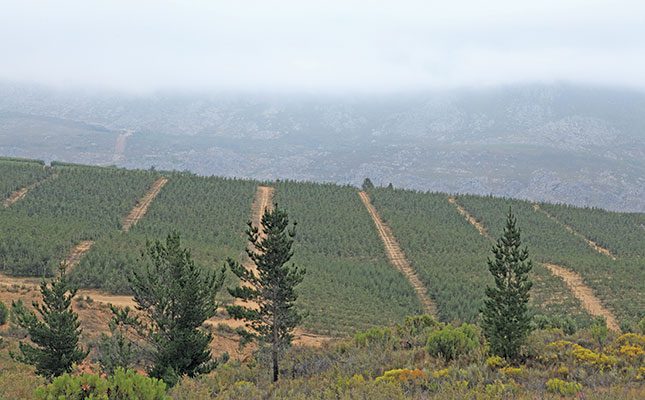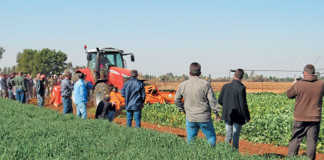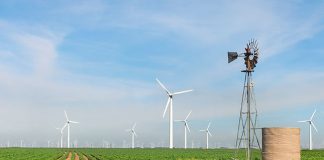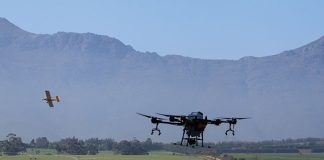
Photo: Glenneis Kriel
In late November 2022, Welgemeen Boerdery, which produces pome fruit in the Witzenberg Valley near Ceres in the Western Cape, was honoured by Ceres Fruit Growers (CFG) with awards for the best Golden Delicious and Kanzi apples, as well as the award for the best Abate Fetel pears.
For Hannes Hanekom, who co-owns the farm with his father Izak and brothers Sakkie and Loutjie, the Golden Delicious award was the most significant, considering that more of these apples are produced in South Africa than any other.
“Golden Delicious is one of the oldest commercial apple varieties still being planted in the country. For as long as I can remember, people have been saying its market is disappearing. But for us, it has proved to be a stalwart, particularly when the European market is flat, as most of these apples are sold locally and in Africa,” explains Hannes.
“In a season like the one we’re currently in, when hail damage causes a large percentage of fruit to be diverted to the juice market, the high yields of Golden Delicious can help orchards to at least break even.”
Alternative varieties of apple have emerged over the years, but none so far has been able to top Golden Delicious as the yellow variety of choice.
Opal, for example, which is a natural crossing of Golden Delicious with Topaz, has excellent production potential, is resistant to apple scab and moderately resistant to powdery mildew, but is struggling to gain a foothold in the market.
Hannes explains that Golden Delicious are picked and sent to the market while they’re still relatively green. Strikingly bright-yellow Opals, on the other hand, are picked and dispatched when yellow, so people think they are overripe.
Golden Delicious apples
According to Hannes, the climate in the Witzenberg Valley plays a major part in Welgemeen’s success with Golden Delicious.
“Our low temperatures cause this variety to flower relatively late in the season, rendering the fruit less susceptible to fungal diseases such as Fusarium, and making it easier to grow the fruit to the optimal size and give it a good, natural finish.”
Over the past five years, the Hanekoms have been making a special effort to improve their Golden Delicious earnings per hectare. Today, their long-term production averages around 100t/ ha, with some orchards producing as much as 120t/ ha. Average packout is about 90%, if fruit aimed at the local market is taken into account.
As part of their plan, they removed 3ha that were no longer profitable, bringing their total area under production to 36ha.
“Some of our trees planted in the 1970s are still giving 100t/ha, and we’ll keep them as long as their production is financially viable. But these orchards suffer more sun damage and require more labour to maintain than newer ones planted at higher densities,” says Hannes.
The older trees were produced from seedlings, while the M7 rootstock is used for newer plantings. Other rootstocks, such as M793, are used on the farm’s clay soils to improve plant vigour.
Johan Dippenaar, who manages Welgemeen’s pome fruit unit, has been focusing on improving soil fertility in the marginal orchards. His plan is to use mulch made of wood chips from trees taken out of production, and apply microbes and microbial food via irrigation to boost the biodiversity in the soil.
Hannes explains that their ‘hospital block’ orchards generally have shallow and compact clayish soils, so mulch is used to create an additional and more favourable growth layer for the roots of the trees.
Mulch, he adds, also helps to reduce evaporation and keep the soil cool, which, in turn, helps protect the roots and prevent the soil organisms from drying out.
Refined regime
Golden Delicious apples tend to bruise more easily than most other varieties, so the Hanekoms have refined their picking regime over time.
In this regard, orchard rows had been increased to a maximum of 50m in length, and paths have been established for the tractors. This means that workers no longer have to squeeze past tractors in the rows, which would often result in fruit being bruised. Instead, they walk a maximum of 25m in either direction to deliver their fruit to the tractors.
The fruit is not picked too early in the morning as it is relatively cold at that stage and bruising occurs more easily. Picking teams are also capped at 12 people, as opposed to the 16 or more used to pick varieties that don’t bruise as easily.
“We invest a lot in the training of our workers, and over time we’ve built a core group of seasonal workers who work on the farm each year. Pickers are rewarded financially for rapid picking and low levels of damage to the fruit,” says Hannes.
To monitor workers’ performance and calculate their remuneration, the farm uses a tag system, with each worker swiping his or her tag upon completion of a unit of work, such as picking a bag of fruit or thinning a tree.
“When picking Golden Delicious apples, we go back to the basics of fruit picking. Workers have to pick slowly and carefully, or all of the effort put into growing the perfect apple will be for nothing,” says Hannes.
Chemical sprays
The trees are sprayed with the plant-growth regulators Promelin and ReTain. And while these are expensive (ReTain alone cost around R12 000/ha last season), Hannes says they are worth it.
He adds that spraying the trees with Promelin during the blooming phase helps to give the apples a smooth finish and a slightly elongated shape.
ReTain, on the other hand, slows the ripening process and, in effect, lengthens the picking window. It also keeps the apples greener for longer, which extends the marketing window.
Abate Fetel Pears
Hannes recalls that in 1994, his father visited Europe with CFG, and it was here that he saw the Abate Fetel pear variety for the first time and decided to grow it on the farm.
Coincidentally, a nearby nursery had some stock of the plant material on BP rootstocks, as the rootstocks used in Europe were not available in South Africa at the time.
Izak planted the trees on the farm’s best soil, but this turned out to be a mistake, according to Hannes.
“The rootstocks were highly vigorous, which resulted in the trees producing a lot of foliage, but hardly any fruit. And the fertile soil only exacerbated the situation,” he recalls.
The yields from these trees were variable, too, and they would find themselves picking 20t one year and between 5t and 10t the next.
Shortly after Hannes joined the farm in 1998, he sawed the trees in half in an attempt to manipulate the growth from scratch. This, however, proved unsuccessful, and the trees were uprooted a few years later.
In 2004, he decided to try Abate Fetel once more, but this time used BA29, a dwarfing rootstock that promised greater production of fruit as opposed to foliage.
Soon after, however, he was advised that BA29 was incompatible with Abate Fetel!
“I was told the rootstock wasn’t strong enough to support the variety. So when we planted the trees we supported them with poles, which helped to prevent breakages. We lost only two of these trees, and continue to plant all our Abate Fetel on BA29.”
Today, Welgemeen has 7ha under Abate Fetel, with trees bearing between 65t/ha and 80t/ ha every year. The first trees were planted at a density of 4,5m x 1,5m, resulting in around 1 482 trees/ha. Later trees were planted at a density of 4m x 1m, giving 2 500 trees/ ha, and the Hanekoms are now experimenting with trees planted in a V-system at a density of 2 800/ha.
Strict measure
Hannes ascribes most of their success with pears to their strict pruning and thinning regime.
“Our programme stimulates the production of large fruit and helps to prevent alternate bearing, which we experienced with this variety when the trees were still young,” he says.
The trees are thinned towards the end of August. Three or four flowers are left on each branch, and thick branches are cut to the length of the pruning shears.
Just after flowering in September, the trees are girdled by cutting a ring halfway around the circumference of each one. Hannes explains that this helps to “choke growth” and influences the set and number of buds that will be produced the following season.
After some of the fruit has dropped naturally, the rest is thinned between the end of October and early November, leaving one or two pears on each branch depending on its thickness.
Abate Fetel pears don’t bruise as easily as Golden Delicious, but the same picking regime is used.
Hannes explains that the large pears, which weigh between 300g and 350g each, need to be packed carefully into containers to prevent their stalks from cutting into one another’s flesh.
“We’d rather spend an extra rand or two per crate by picking slowly and carefully, than lose the fruit we’ve invested so much in,” says Hannes.
He adds that Abate Fetel can be “big money-spinners” if they are large enough and the market is right.
“Abate Fetel is one of Europe’s favourite pear varieties, but the fruit has to be big. We can send smaller fruit to Russia, but the war in Ukraine has made this difficult. Countries outside of Europe aren’t familiar with the variety, so there isn’t good demand for it there.”
Kanzi apples
According to Sakkie, the Hanekoms had the choice of producing either Jazz or Kanzi apples, both of which are Royal Gala-Braeburn crosses. In the end, they went with Kanzi, as CFG and Tru-Cape had a strong marketing campaign for this variety in Europe.
Today, Welgemeen has around 7ha under Kanzi apples, which were planted in 2011 and 2013. So far, however, the variety has failed to impress them, and Sakkie says they are still struggling to get the packouts they achieve with their other varieties: “Kanzi production averages around 100t/ha, but only 50% of the fruit is suited to the fresh market.”
He remarks that one of the farmers in the region removed his Kanzi orchards, saying he
“wasn’t going to grow an apple that had to be sprayed to look like an apple”.
Sakkie explains that Kanzi apples have very short stalks in comparison with other varieties, and these are therefore lengthened with chemical treatment. Failing to do so results in clusters of apples that bruise one another as they grow, and the stalks breaking off during picking.
“This is a problem, because the market doesn’t want fruit without stalks,” he adds.
Low demand
There is little demand for Kanzi outside of Europe, as local consumers are unfamiliar with the variety. Apples that don’t conform to export standards for size and colour are therefore juiced.
“In a normal year, we can make good money with Kanzi, but it isn’t as profitable as Royal Gala, for instance. We’d need to improve our production recipe to make Kanzi worth our while in the long run,” says Sakkie.
This cultivar is also prone to developing bitter pit, and its picking window falls exactly in the middle of those of the Golden Delicious and red varieties, which means that even more workers are needed to pick all the fruit on time.
On top of this, Kanzi orchards have to be picked more than once due to uneven ripening, and this drives up production costs. Although the aim is to pick the trees clean within two rounds of picking, workers have had to pick as many as four times in some years when the fruit ripened unevenly due to unfavourable climatic conditions.
Ronald Vermeulen, a Kanzi consultant from the Netherlands, visits South Africa every year, sharing technical advice and new insights on how this variety should be managed.
“This is a great help, but there’s still some trial and error involved, as his information is based on European conditions. Our trees are also planted on M7 rootstocks, which are much more vigorous than the M9 rootstocks on which Kanzi trees are planted there,” explains Sakkie.
He adds that one of Vermeulen’s most useful tips was to refresh each tree every four years, as two- to three-year-old branches bear the best fruit. They therefore remove three- to four-year-old branches to allow for new growth and prevent the overshadowing of fruit, which negatively affects size and quality. Thanks to the trees’ vigour, new branches grow quickly.
Sakkie says that despite these problems, they have still managed to win the award for best Kanzi production more than once.
“We’d never have achieved the success that we have on Welgemeen if it hadn’t been for our staff. Our farm manager, Johan, in particular, has done ‘miracle work’ in our orchards,” he adds.
Email Hannes Hanekom at [email protected], or Sakkie Hanekom at [email protected].










